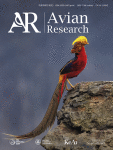Grabenstein, K. C., Otter, K. A., Burg, T. M., and Taylor, S. A. (2022)
Sympatry leads to reduced body condition in chickadees that occasionally hybridize. Ecology and Evolution 12: e8756.
https://doi.org/10.1002/ece3.8756
Abstract:
Both abiotic and biotic drivers influence species distributions. Abiotic drivers such as climate have received considerable attention, even though biotic drivers such as hybridization often interact with abiotic drivers. We sought to explore the (1) costs of co-occurrence for ecologically similar species that hybridize and (2) associations between ecological factors and condition to understand how abiotic and biotic factors influence species distributions. For two closely related and ecologically similar songbirds, black-capped and mountain chickadees [
Poecile atricapillus and
Poecile gambeli], we characterized body condition, as a proxy for fitness, using a 1358-individual range-wide dataset. We compared body condition in sympatry and allopatry with several abiotic and biotic factors using species-specific generalized linear mixed models. We generated genomic data for a subset of 217 individuals to determine the extent of hybridization-driven admixture in our dataset. Within this data subset, we found that ~11% of the chickadees had hybrid ancestry, and all hybrid individuals had typical black-capped chickadee plumage. In the full dataset, we found that birds of both species, independent of demographic and abiotic factors, had significantly lower body condition when occurring in sympatry than birds in allopatry. This could be driven by either the inclusion of cryptic, likely poor condition, hybrids in our full dataset, competitive interactions in sympatry, or range edge effects. We are currently unable to discriminate between these mechanisms. Our findings have implications for mountain chickadees in particular, which will encounter more black-capped chickadees as black-capped chickadee ranges shift upslope and could lead to local declines in mountain chickadee populations.

www.sciencedirect.com










